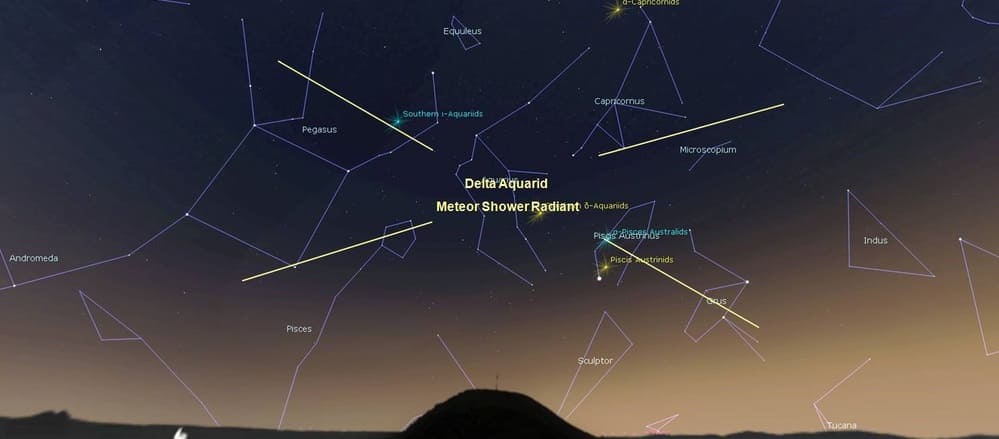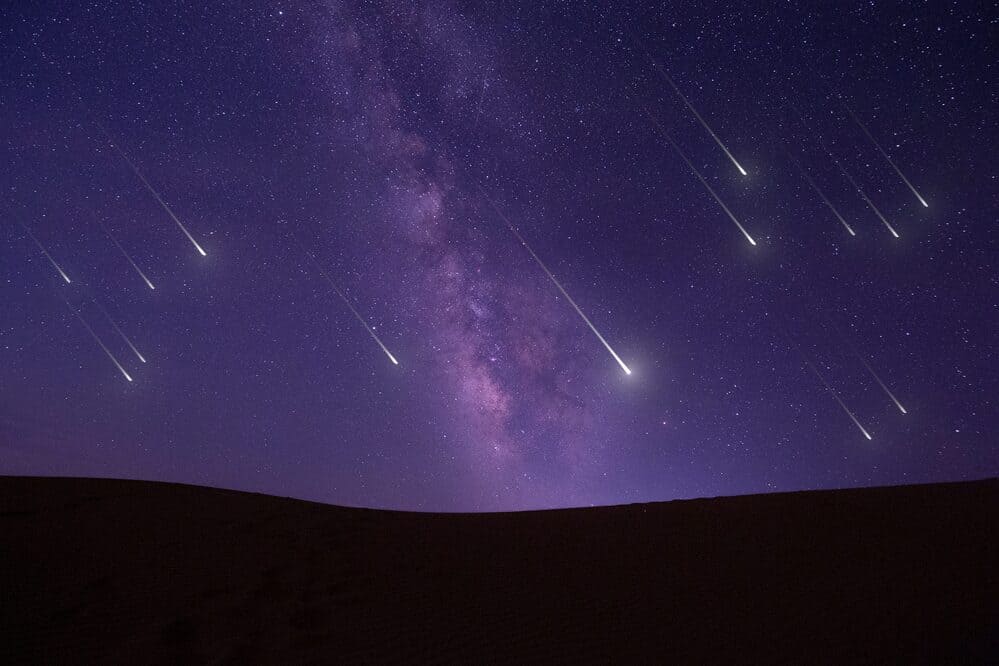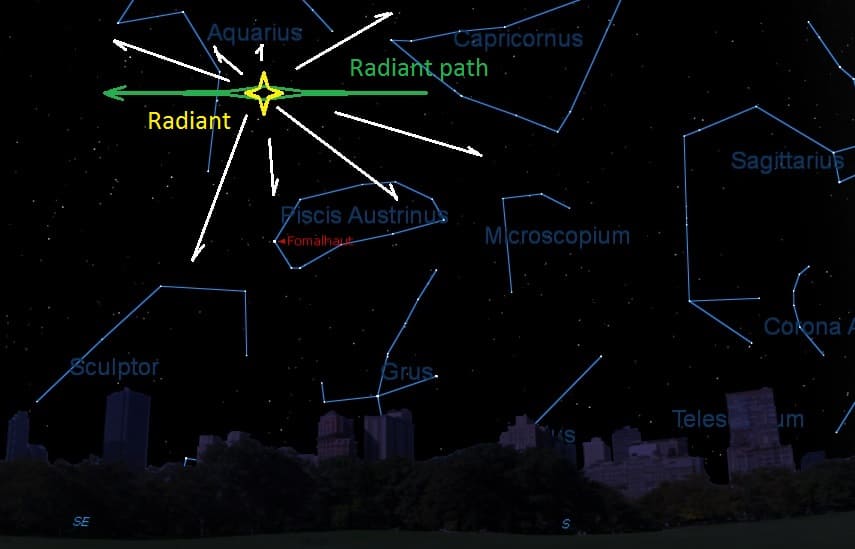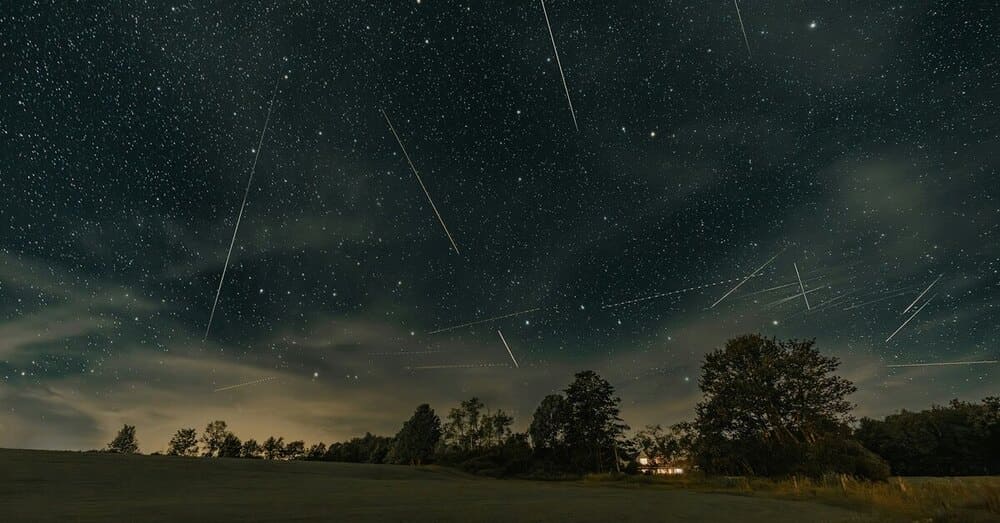The origin of the Delta Aquariids
The Delta Aquariids meteor shower is named after the constellation Aquarius, where the meteors appear to originate. Specifically, they seem to radiate from near the star Delta Aquarii, hence the name. This meteor shower is linked to the debris left behind by the Marsden and Kracht comet groups. As these comets orbit the sun, they shed particles that enter Earth’s atmosphere, creating the beautiful streaks of light we observe.
What are meteor showers?
Meteor showers occur when Earth passes through a stream of debris left by comets or asteroids. As these particles, typically no larger than a grain of sand, collide with our atmosphere at high speeds, they burn up, creating bright flashes of light known as meteors. Meteor showers can be predicted and are often named after the constellation from which they appear to emanate.
Understanding Delta Aquariids meteor shower

History and Discovery
The Delta Aquariids meteor shower has been observed for centuries, but its exact origins were only identified in the early 20th century. Astronomers studying historical records and conducting observations concluded that this meteor shower is associated with the comet groups Marsden and Kracht.
Characteristics of Delta Aquariids
The Delta Aquariids are known for their faint meteors, which typically travel at a moderate speed of around 41 kilometers per second. Observers can expect to see up to 20 meteors per hour during the peak. These meteors often lack persistent trails but can sometimes produce bright fireballs.
When and where to see the Delta Aquariids meteor shower
Peak viewing times
The Delta Aquariids Meteor Shower peaks between July 28 and July 30 each year. The best time to observe this meteor shower is after midnight and before dawn. During these hours, the radiant point, located in the constellation Aquarius, is highest in the sky, providing optimal viewing conditions.
Best locations for viewing
For the best viewing experience, find a location far from city lights, where the sky is darkest. Rural areas, national parks, and remote locations with minimal light pollution offer the best opportunities to see the Delta Aquariids in their full glory. In the Southern Hemisphere, the radiant point is higher in the sky, providing better viewing opportunities.
How to prepare for viewing the Delta Aquariids meteor shower
Essential Gear and Equipment
To fully enjoy the Delta Aquariids meteor shower, come prepared with the right gear. Bring a comfortable chair or blanket to sit on, and dress warmly, as nights can be chilly even in summer. A thermos of hot drink can also make the experience more pleasant. Binoculars or a telescope aren’t necessary, as the meteors are best viewed with the naked eye.

Planning your viewing experience
Plan your viewing experience around the moon phase. A new moon or a crescent moon will provide the darkest skies, enhancing visibility. Check local weather forecasts to ensure clear skies and avoid nights with high cloud cover. Arrive at your chosen location early to allow your eyes to adjust to the dark, and switch off any unnecessary lights.
Viewing tips for the Delta Aquariids meteor shower
Optimal conditions for viewing
For the best view of the Delta Aquariids, lie on your back and look towards the southern sky. Give your eyes 20-30 minutes to adjust to the darkness. Avoid using your phone or any bright lights, as they can hinder your night vision. Patience is key; the longer you watch, the more meteors you are likely to see.
Safety considerations
Safety is paramount when stargazing. Ensure you are in a safe location, preferably with a group. If you are in a remote area, inform someone of your whereabouts. Bring a flashlight with a red filter to preserve night vision without disturbing others.
Scientific significance of the Delta Aquariids meteor shower
Contributions to Astronomy
Meteor showers like the Delta Aquariids provide valuable data for astronomers. Studying these events helps scientists understand the composition of comets and the behavior of meteoroids in our atmosphere. The consistent annual occurrence of the Delta Aquariids allows for long-term studies and data collection.

Delta Aquariids and space exploration
The study of meteors and meteor showers contributes to our broader understanding of the solar system. By analyzing the particles that create meteor showers, scientists gain insights into the early solar system’s formation and the ongoing processes that shape it.
Cultural and historical significance of meteor showers
Meteor showers in mythology and folklore
Throughout history, meteor showers have been subjects of awe and wonder, often interpreted as omens or messages from the gods. Various cultures have myths and legends associated with meteors, viewing them as celestial signs.

Modern cultural references
Today, meteor showers continue to inspire awe and are celebrated in various cultural references. From literature and films to art and music, the beauty and mystery of meteor showers captivate our imagination and remind us of our place in the cosmos.
The future of the Delta Aquariids meteor shower
Predictions and trends
The Delta Aquariids Meteor Shower is expected to continue delighting skywatchers for many years to come. Advances in technology and increasing interest in amateur astronomy will likely enhance our understanding and appreciation of this celestial event.
Conservation of dark skies
As light pollution increases, preserving dark skies becomes more important for enjoying meteor showers and other astronomical phenomena. Efforts to reduce light pollution and protect dark sky areas are crucial for future generations to experience the wonder of meteor showers like the Delta Aquariids.
Frequently asked questions
When is the best time to view the Delta Aquariids Meteor Shower?
The best time to view the Delta Aquariids meteor shower is during its peak, typically around July 28-30, between midnight and dawn.
What causes the Delta Aquariids Meteor Shower?
The Delta Aquariids meteor shower is caused by Earth passing through the debris left by the Marsden and Kracht comet groups, resulting in particles entering our atmosphere and burning up as meteors.
How can I photograph the Delta Aquariids Meteor Shower?
To photograph the Delta Aquariids, use a camera with a wide-angle lens and set it on a tripod. Use a long exposure setting and a high ISO to capture the meteors against the night sky.
Are there any special events related to the Delta Aquariids?
Various astronomy clubs and organizations often host events and viewing parties during the peak of the Delta Aquariids Meteor Shower. Check local listings and online forums for information on events near you.
What other meteor showers are visible around the same time?
The Delta Aquariids overlap with the Perseids Meteor Shower, which peaks in mid-August. Observers can often see meteors from both showers in late July and early August.
How can I contribute to meteor shower research?
Amateur astronomers can contribute by counting meteors and reporting their observations to organizations like the International Meteor Organization (IMO). Participation in citizen science projects also helps researchers collect valuable data.


